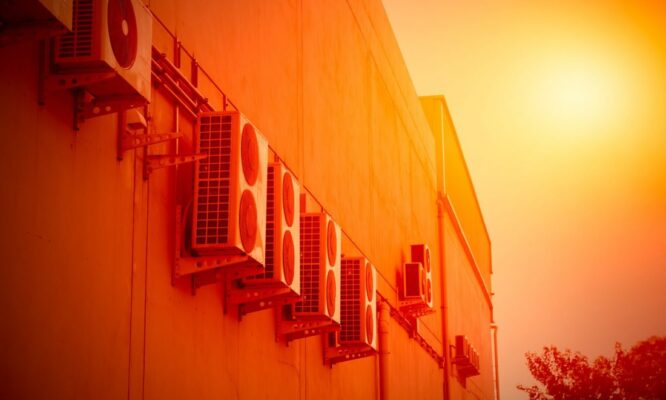Today we can fairly say that air conditioning has become a staple in almost everyone’s life. Not a luxury anymore, it has become a necessity now. Buying an air conditioner is probably the most comfortable option a person can go for in response to climate change. But we forget how power-hungry these appliances are. A small single-room unit, on average, consumes the power required to run four fridges, and a central one consumes the power required to run over 15. Most air conditioners use a refrigerant that emits gasses responsible for climate change and ozone layer depletion. Studies predict that by 2050, around 25 percent of global warming will result from air conditioning activities.
Here are some facts and figures that can’t be overlooked as we discuss how air conditioning impacts our planet, and what we can do about it.
CFCs/HFCs
These are cooling agents used in the ACs and release gas byproducts. This gas is very harmful, as it increases the hole in the ozone layer. Fortunately, modern-day refrigerants, which are hydro fluorocarbons or HFCs, have less effect on the ozone layer, but they contribute heavily to the greenhouse mechanism and its effect. In fact, these hydrofluorocarbons are a thousand times more potent than CO2.
ENERGY USE
Air conditioners require a good amount of energy to work well, and this energy, as electricity, is derived byburning fossil fuels. They are burnt to generate power and as a byproduct release carbon dioxide into the air. A typical AC runs at an average rate of 3000 to 5000 watts per hour, depending upon how warm the air is – the warmer it gets, the more power it uses.
UNCLEAN DUCTS
Dust and bacteria GETS accumulated in the ducts used with our air conditioners and every time we switch it on, these are pushed through our homes, eventually making the surrounding air unhealthy to breathe.
MATERIALS USED
To reduce the weight and cost of production of the units, manufacturers are transitioning most of the air conditioner parts to be made from iron to plastic. Although both metal and plastic are bad for the environment, plastic alone is a non-biodegradable material and is less likely to be recycled and last as long as metals. 50% of the plastic is only used once, which makes it a big no for our ecosystem.
AIR QUALITY
Improving and maintaining the indoor air quality (IAC) of your home is one of the major jobs of an air conditioner. That’s why it is crucial and recommended to perform regular maintenance on your HVAC systems. You can start with regularly changing air filters and gradually moving to install a humidifier and home air purification and UV light systems for improving IAQ.
RAPIDLY GROWING NUMBERS
According to the International Energy Agency, there are around 1.6 billion ventilation, heating, and air conditioning (HVAC) units in the world, and the number is expected to grow to 5.6 billion by 2030.
USE OF FUTURISTIC TECHNOLOGIES TO TACKLE CHALLENGES
Brands like Mitsubishi are now coming up with more sustainable air conditioning solutions by manufacturing chlorine-free, energy-efficient and more eco-friendly units with Low Global Warming Potential (LGWP).
SHIFT FROM CONCRETE AND GLASS BUILDINGS
A shift from traditional to ergonomic architecture can be a cheaper, more beneficial, and long-run solution to the problem. Ergonomic buildings remain cool and have less pressured ACs and less the pressure on the machine, it will save more energy.
In a market like India, where there is still a wide gap between megacities and tier 2 towns and villages, there’s a major need to endorse newer, more sustainable technologies. Spreading awareness of the present-day challenges and bringing change to the way people use ACs is the need of the hour for us. Only by encouraging such cultural and societal shifts can we move closer towards a healthier and more sustainable future for our planet.
Written by: Tazeen Ansari

